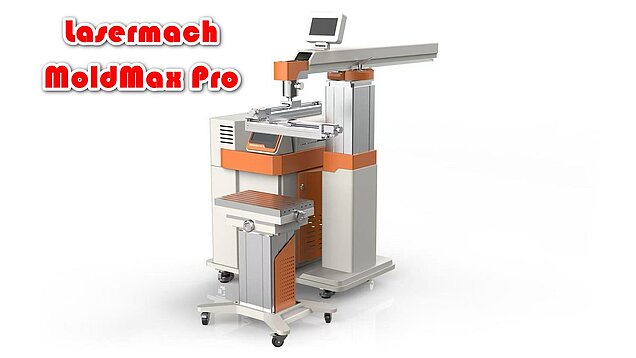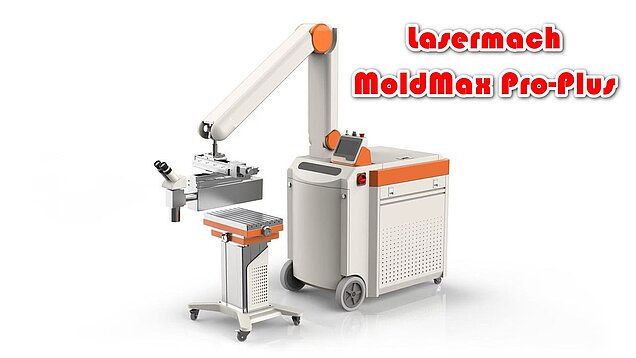Discover the Lasermach Moldmax laser systems for moulds and moluding
Moldmax laser welding machines using our photonweld technology
Laser systems find many applications in mould making and moulding processes of plastic, rubber, glass or metal materials.
One of the most common uses of laser welding is in the repair and maintenance of moulds by material filling: it is a semi-automatic process in which the operator’s skill is supported by a very stable, repeatable technology and software functionality that facilitates processing.
In addition, the laser has a very localised thermal impact, therefore minimal, leaving the mechanical characteristics of the material unchanged and minimising post-processing activities.
Lasermach offers an extended range of laser welding systems , from simpler and compact models for welding on small molds and inserts, to versions dedicated to machining on medium-sized parts, to the big series that allows maximum flexibility and ease of use even on large molds or huge other parts difficult to move
The Moldmax laser welding machne can be used not only for mould repair and maintenance, but also for repairing parts produced by die casting (again with material input), or for welding mechanical parts in various areas like repairing a cilinderblock from a 12 cylinder motor while not dismounting the motor.
Moldmax laser repairing of molds
Manufacturing moulds and tools can be a costly process, and their service lives are often shortened due to wear and tear, damage, and corrosion. However, laser welding has emerged as a promising solution to significantly enhance the lifespan of moulds and tools through laser deposition welding. The Die Mould Laser Welding Machine, developed by Lasermach, offers exceptional performance and flexibility in this regard.
Our robust and high-performance Die Mould Laser Welding Machine enables the welding of intricate structures that would otherwise be challenging or even impossible to weld using traditional welding technologies. This is particularly advantageous when working with delicate materials such as plastic or glass. With precise control over laser energy and exposure time, the machine allows for welding of metallic materials with high melting temperatures and excellent thermal conductivity. Moreover, it possesses the capability to weld different types of metals, further expanding its versatility.
Lasermach's MoldMax laser welding and mold maintenance system with fiber source.
Moldmax has been specially designed to perform modifications and repairs to molds damaged by wear or use.
The use of lasers, with the addition of materials, has revolutionized the traditional welding techniques of molds, allowing repairs without the need of preheating. This avoids the common collateral damage induced by traditional welding, such as geometric distortions, edge burns and decarburization.
Thanks to the properties of the laser beam, complex areas such as narrow and deep grooves, or internal and external edges, can be welded. The metallurgical quality of the weld meets the highest standards on all steels, copper alloys, and aluminum. The hardness of the welding layers can reach very high values without the need for subsequent heat treatments. Its simple way of operating and perfect visual inspection of the filler material, using a stereomicroscope, make this technology accessible to everyone, without having to rely on highly qualified technicians.
Moldmax is powered by a new generation laser source that offers greater energy efficiency and allows for high productivity.
Productivity
- The new MoldMax introduces more process stability and a high-quality laser beam. These features increase the production rate, while consistently guaranteeing flawless process execution.
Maintenance-free
- The new MoldMax does not have any consumable parts and is maintenance-free. The engineering team has pushed the boundaries of energy efficiency, making this the most efficient MoldMax ever made.
Advanced software functions
- The processing parameters are managed through software that allows any operator to carry out advanced welding operations practically and intuitively. These software functions include welding along circular paths, on inclined planes, filling, and the overlap function for executing extremely regular weld seams.
Tool Steel-
Cold Work : 1.4718, SKD11, Dell, Dc53.
High Speed : 1.3348, SKH 55.
Hot Work : X25CrMoS, SKD61, DHA1, DH2F.
Plastic Work : 1.2311, S45-50-SSC, P-20, NAK80 Px4, Stavax, M300.
Gray Casting Iron – GG 20, GG 25,(FC), GGG 40, GGG 50, GGG 60, GGG 70L, GGG, 90(FCD).
Special Materials – Super alloys, Colmonoy, Stellite, Duplex Stainless steel, Aluminum, Titanium, Inconel alloys, Hastelloy, Ni-Resist, Magnesium, Molybdenum, Nickel, Silver, Tin, Zinc, Silver, Gold.
Special Process – Etching, Mirror finishing.



